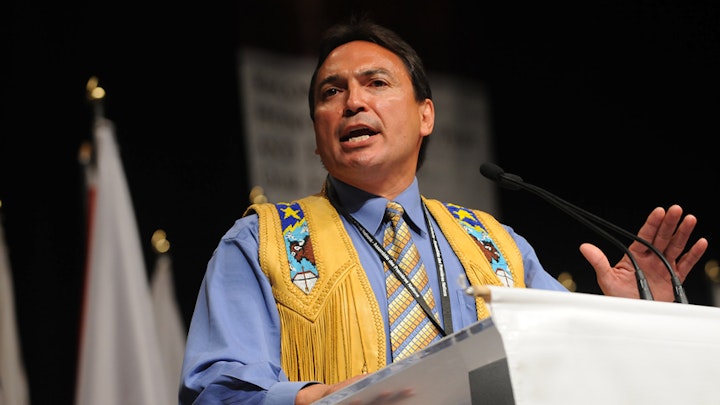Perry Bellegarde, re-elected National Chief of the Assembly of First Nations in 2018, holds a wealth of leadership experience. He’s spent the past thirty years putting into practice his strong beliefs on the laws and traditions instilled in him by the many Chiefs and Elders he has known over the years. Passionate and unrelenting in creating real, measurable progress on the priorities that matter most to First Nations, National Chief Bellegarde is a strong advocate for honouring and implementing Inherent and Treaty rights, title and jurisdiction.
Originally from Little Black Bear First Nation in Treaty 4 Territory, he has served as Tribal Council Representative for the Touchwood-File Hills-Qu’Appelle Tribal Council, Chief of the Federation of Saskatchewan Indian Nations and Saskatchewan Regional Chief for the Assembly of First Nations, as well as Chief and Councillor for the Little Black Bear First Nation. He has experience and expertise in leadership at all levels of First Nations governance. In 2014, the Chiefs-in-Assembly first elected Perry as National Chief of the Assembly of First Nations. He was re-elected to the position in July 2018.
As Assembly of First Nations National Chief, Perry Bellegarde remains committed to building on the momentum created in his first term. His national platform and agenda, Closing the Gap, remains a top priority and has directly influenced the federal government’s planning and priorities.
National Chief Bellegarde has been recognized numerous times as a First Nations leader. He has been awarded the Confederation Medal, the Saskatchewan Medal, and the Queen’s Jubilee Medal on two separate occasions. This year, the Province of Saskatchewan recognized Perry with the Saskatchewan Order of Merit.
National Chief Bellegarde remains grateful for the strength and vision he has gained from the Elders. He vows to always place great importance on respecting their teachings. Their guidance has made him a man of foresight and a leader for generations.
First Nation leaders (Chiefs) from coast to coast to coast direct the work of AFN through resolutions passed at Chiefs Assemblies held at least twice a year. The AFN National Executive is made up of the National Chief, 10 Regional Chiefs and the chairs of the Elders, Women’s and Youth councils. Regional Chiefs are elected every three years by Chiefs in their regions. Chiefs, who are elected by the citizens and members of their respective communities, elect the National Chief every three years.
The role of the National Chief and the AFN is to advocate on behalf of First Nations as directed by Chiefs-in-Assembly. This includes facilitation and coordination of national and regional discussions and dialogue, advocacy efforts and campaigns, legal and policy analysis, communicating with governments, including facilitating relationship building between First Nations and the Crown as well as public and private sectors and general public.
The term “First Nations” refers to one of three distinct groups recognized as “Aboriginal” in the Constitution Act of 1982. The other two distinct groups characterized as “Aboriginal” are the Métis and the Inuit.
There are 634 First Nation communities (also known as reserves) in Canada, with First Nation governments. First Nations are part of unique larger linguistic and cultural groups that vary across the country. In fact, there are over 50 distinct nations and language groups across the country.
First Nations have a unique and special relationship with the Crown and the people of Canada as set out in the Royal Proclamation of 1763 and manifested in Treaties, the Constitution Acts of 1867 and 1982, Canadian common law and International law and as outlined in the United Nations Declaration on the Rights of Indigenous Peoples.
This special relationship between First Nations and the Crown is grounded in First Nation inherent and Aboriginal rights and title, Treaties and negotiated agreements with a view toward peaceful coexistence, mutual respect, recognition and the equitable sharing of lands and resources. Many Treaties, reflected in written documents, wampum and oral understanding, were entered into between First Nations and the British Crown (the Government of Canada after Confederation) between 1701 and 1923. Treaty promises and agreements included non-interference, protection of hunting and fishing rights, sharing of lands and resources, health and education benefits, economic tools and benefits for the duration of the Treaty relationship.

Voici le lien pour l'entrevue
Les chefs des Premières Nations d'un océan à l'autre dirigent le travail de l'APN au moyen de résolutions adoptées lors des assemblées des chefs tenues au moins deux fois par année. L’exécutif national de l’APN est composé du chef national, de 10 chefs régionaux et des présidents des conseils des aînés, des femmes et des jeunes. Les chefs régionaux sont élus tous les trois ans par les chefs de leur région. Les chefs, élus par les citoyens et les membres de leurs communautés respectives, élisent le chef national tous les trois ans.
Le rôle du chef national et de l'APN est de défendre les intérêts des Premières Nations selon les directives des chefs en assemblée. Cela comprend la facilitation et la coordination des discussions et du dialogue nationaux et régionaux, les efforts et campagnes de défense des droits, l'analyse juridique et politique, la communication avec les gouvernements, y compris la facilitation de l'établissement de relations entre les Premières Nations et la Couronne ainsi que les secteurs public et privé et le grand public.
Le terme «Premières nations» fait référence à l'un des trois groupes distincts reconnus comme «autochtones» dans la Loi constitutionnelle de 1982. Les deux autres groupes distincts qualifiés d '«autochtones» sont les Métis et les Inuits.
Il y a 634 communautés des Premières Nations (également appelées réserves) au Canada, avec des gouvernements des Premières Nations. Les Premières Nations font partie de grands groupes linguistiques et culturels uniques qui varient d'un bout à l'autre du pays. En fait, il existe plus de 50 nations et groupes linguistiques distincts à travers le pays.
Les Premières Nations ont une relation unique et spéciale avec la Couronne et le peuple du Canada, comme le stipule la Proclamation royale de 1763 et qui se manifeste dans les traités, les lois constitutionnelles de 1867 et 1982, la common law canadienne et le droit international, Déclaration des Nations Unies sur les droits des peuples autochtones.
Cette relation spéciale entre les Premières Nations et la Couronne repose sur les droits et titres inhérents et ancestraux des Premières Nations, les traités et les accords négociés en vue de la coexistence pacifique, du respect mutuel, de la reconnaissance et du partage équitable des terres et des ressources. De nombreux traités, reflétés dans des documents écrits, des wampums et une entente orale, ont été conclus entre les Premières Nations et la Couronne britannique (le gouvernement du Canada après la Confédération) entre 1701 et 1923. Les promesses et accords issus des traités comprenaient la non-ingérence, la protection de la chasse et de la pêche droits, partage des terres et des ressources, avantages pour la santé et l'éducation, outils et avantages économiques pour la durée de la relation du traité.

